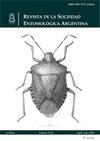巴基斯坦旁遮普省费萨拉巴德白纹伊蚊(双翅目:库蚊科)的季节发生及生物学参数及其防治策略
IF 0.5
4区 农林科学
Q4 ENTOMOLOGY
引用次数: 1
摘要
了解白纹伊蚊(Skuse)的季节性流行和生物学参数对种群估计、有效的媒介控制和登革热预防策略是必不可少的。Ae.的采样。在整个研究季节,通过使用蚊帐和诱卵器收集白纹伊蚊的卵、幼虫、蛹和成虫,每周至少收集一次。Ae的出现。白纹伊蚊种群分布不均,10月为季风后季节。1 - 5月种群数量逐渐增加,6 - 7月和9 - 11月种群数量急剧减少,为繁殖高峰期。但12 - 2月密度最低。Ae的生长。在标准化实验室条件下,以Balb/C小鼠为血粉饲喂成蚊,白纹伊蚊卵孵化时间分别为3、1.3、1.2、1.7、2.8 d, 1、2、3、4龄幼虫发育。化蛹发育、成虫羽化、从卵孵化到成虫羽化的总寿命、雄虫和雌虫的寿命分别为7、3、20、25和30 d。白纹伊蚊密度占其他蚊属(库蚊和按蚊)密度的1%,埃及伊蚊(L)密度为3%,表明两种伊蚊共存。本文章由计算机程序翻译,如有差异,请以英文原文为准。
Seasonal occurrence and biological parameters of Aedes albopictus (Skuse) (Diptera: Culicidae) as management tactics in Faisalabad, Punjab, Pakistan
Understanding the seasonal prevalence and biological parameters of mosquito Aedes albopictus (Skuse) are indispensable for population estimates, efficient vector control and dengue prevention tactics. The sampling of Ae. albopictus was completed through the collection of eggs, larvae, pupae and adults throughout the study seasons by use of nets and ovitraps at least once a week. Occurrence of Ae. albopictus was distinguished heterogeneously and populations were observed maximum in October post-monsoon season. The populations increased progressively from January-May and sharply deteriorated in June-July and September-November months revealing the highest breeding. However, the lowest density was observed during December-February. Growth of Ae. albopictus evaluated under standardized laboratory conditions with the provision of Balb/C mice as blood meal to adult mosquitoes, exhibited eggs hatching, and first, second, third and fourth instar larvae development in 3, 1.3, 1.2, 1.7 and 2.8 days, respectively. Nevertheless, pupation development, adult emergence, total life duration from egg hatching to adult emergence, male and female life spans persisted for 7, 3, 20, 25 and 30 days, respectively. Aedes albopictus accounted for 1% density of other mosquito genera collected (Culex and Anopheles), while, Aedes aegypti (L) was 3% abundant and indicated that both Aedes species had coexistence.
求助全文
通过发布文献求助,成功后即可免费获取论文全文。
去求助
来源期刊

Revista De La Sociedad Entomologica Argentina
Agricultural and Biological Sciences-Insect Science
CiteScore
0.80
自引率
20.00%
发文量
31
审稿时长
20 weeks
 求助内容:
求助内容: 应助结果提醒方式:
应助结果提醒方式:


